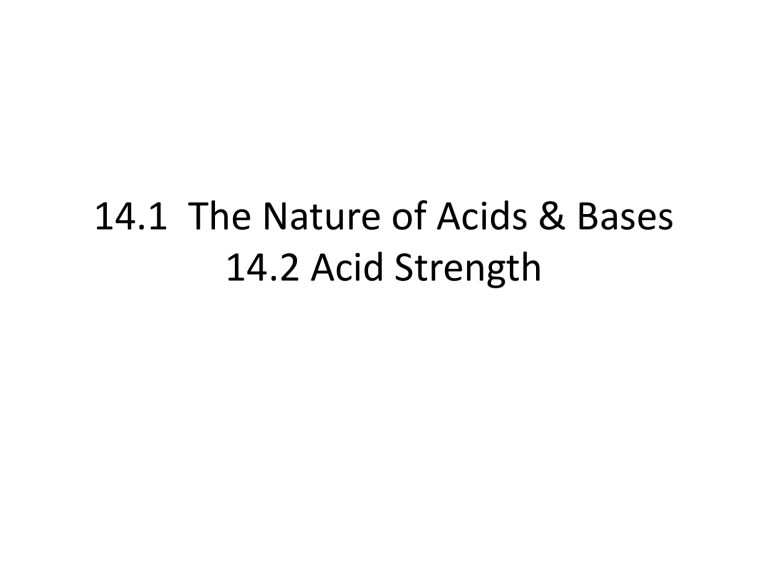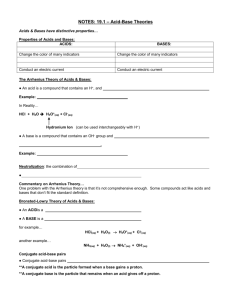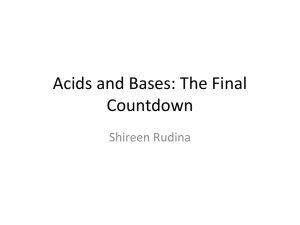
14.1 The Nature of Acids & Bases
14.2 Acid Strength
Why study acid-base chemistry?
• It is a very important class of chemical
reactions
o Acid-Base reactions
o Precipitation reaction
o Redox reactions
• Acid-base reactions are essential to
living systems
• There are MANY industrial
applications. (H2SO4 is one of the most
important industrial chemicals)
Copyright © Cengage Learning. All rights reserved
2
Acid-Base Definitions
Arrhenius (1859-1927) was the first to define
acids & bases.
Arrhenius Acid-Base definitions:
• Acids produce H+ ions in solution
HCl H+ + Cl• Bases produce OH- ions.
NaOH Na+ + OH-
Acid-Base Definitions
Brønsted–Lowry(1859-1927) was the first to define
acids & bases.
Brønsted–Lowry Acid-Base definitions:
• Acids are proton (H+) donors
• Bases are proton acceptors
HCl + H2O H3O+ + ClThis is an improved definition –because it expands
Arrhenius’s definition
NH3 + H2O NH4+ + OHIt also implies that acids and bases always are
paired
Acid in Water
HA(aq)
+
H2O(l)
H3O+(aq) +
A-(aq)
• Conjugate base the acid molecule after a proton is
lost.
• Conjugate acid forms when the proton is transferred
to the base.
Copyright © Cengage Learning. All rights reserved
5
14.2 Acid Strength
• Strong acid:
– Ionization equilibrium lies far to the right.
– Yields a weak conjugate base.
• Weak acid:
– Ionization equilibrium lies far to the left.
– Weaker the acid, stronger its conjugate base.
Copyright © Cengage Learning. All rights reserved
6
14.2 Acid Strength
How is a strong acid different than a week acid?
Copyright © Cengage Learning. All rights reserved
7
Various Ways to Describe Acid
Strength
Copyright © Cengage Learning. All rights reserved
8
Water as an Acid and a Base
• Water is amphoteric:
– Behaves either as an acid or as a base.
H2O (l) + H2O (l) H3O+ (aq) + OH- (aq)
K=?
• At 25°C:
Kw = [H+][OH–] = 1.0 × 10–14
• No matter what the solution contains, the product of
[H+] and [OH–] must always equal 1.0 × 10–14 at
25°C.
Copyright © Cengage Learning. All rights reserved
9
Three Possible Situations
• [H+] = [OH–]; neutral solution
• [H+] > [OH–]; acidic solution
• [OH–] > [H+]; basic solution
Copyright © Cengage Learning. All rights reserved
10
Self-Ionization of Water
To play movie you must be in Slide Show Mode
PC Users: Please wait for content to load, then click to play
Mac Users: CLICK HERE
Copyright © Cengage Learning. All rights reserved
11
Review Questions
CONCEPT CHECK!
HA(aq) + H2O(l)
acid
base
H3O+(aq) + A-(aq)
conjugate conjugate
acid
base
What is the equilibrium constant expression for
an acid acting in water?
H3O A
K =
HA
Copyright © Cengage Learning. All rights reserved
12
Review Questions
CONCEPT CHECK!
If the equilibrium lies to the right, the value for Ka
is __________.
large (or >1)
If the equilibrium lies to the left, the value for Ka is
___________.
small (or <1)
Copyright © Cengage Learning. All rights reserved
13
Review Questions
HA(aq) + H2O(l)
H3O+(aq) + A–(aq)
If water is a better base than A–, do products
or reactants dominate at equilibrium?
Does this mean HA is a strong or weak acid?
Is the value for Ka greater or less than 1?
Copyright © Cengage Learning. All rights reserved
14
Review Questions
CONCEPT CHECK!
Consider a 1.0 M solution of HCl.
Order the following from strongest to weakest base
and explain:
H2O(l)
A–(aq) (from weak acid HA)
Cl–(aq)
Copyright © Cengage Learning. All rights reserved
15
Let’s Think About It…
• How good is Cl–(aq) as a base?
• Is A–(aq) a good base?
The bases from strongest to weakest are:
A–, H2O, Cl–
Copyright © Cengage Learning. All rights reserved
16
Review Questions
CONCEPT CHECK!
Consider a solution of NaA where A– is the anion
from weak acid HA:
A–(aq) + H2O(l)
base
acid
HA(aq) + OH–(aq)
conjugate conjugate
acid
base
a) Which way will equilibrium lie?
left
Copyright © Cengage Learning. All rights reserved
17
Review Questions
CONCEPT CHECK!
Consider a solution of NaA where A– is the anion
from weak acid HA:
A–(aq) + H2O(l)
base
acid
HA(aq) + OH–(aq)
conjugate conjugate
acid
base
b) Is the value for Kb greater than or less than 1?
less than 1
Copyright © Cengage Learning. All rights reserved
18
CONCEPT CHECK!
Consider a solution of NaA where A– is the anion
from weak acid HA:
A–(aq) + H2O(l)
base
acid
HA(aq) + OH–(aq)
conjugate conjugate
acid
base
c) Does this mean A– is a strong or weak base?
weak base
Copyright © Cengage Learning. All rights reserved
19
CONCEPT CHECK!
Acetic acid (HC2H3O2) and HCN are both weak acids.
Acetic acid is a stronger acid than HCN.
Arrange these bases from weakest to strongest and
explain your answer:
H2O
Cl–
Copyright © Cengage Learning. All rights reserved
CN–
C2H3O2–
20
Let’s Think About It…
• H2O(l) + H2O(l)
acid base
H3O+(aq) + OH–(aq)
conjugate conjugate
acid
base
• At 25°C, Kw = 1.0 × 10–14
The bases from weakest to strongest are:
Cl–, H2O, C2H3O2–, CN–
Copyright © Cengage Learning. All rights reserved
21
CONCEPT CHECK!
Discuss whether the value of K for the reaction:
HCN(aq) + F–(aq)
CN–(aq) + HF(aq)
is >1
<1
=1
(Ka for HCN is 6.2×10–10; Ka for HF is 7.2×10–4.)
Explain your answer.
Copyright © Cengage Learning. All rights reserved
22
CONCEPT CHECK!
Calculate the value for K for the reaction:
HCN(aq) + F–(aq)
CN–(aq) + HF(aq)
(Ka for HCN is 6.2×10–10; Ka for HF is 7.2×10–4.)
K = 8.6 × 10–7
Copyright © Cengage Learning. All rights reserved
23







